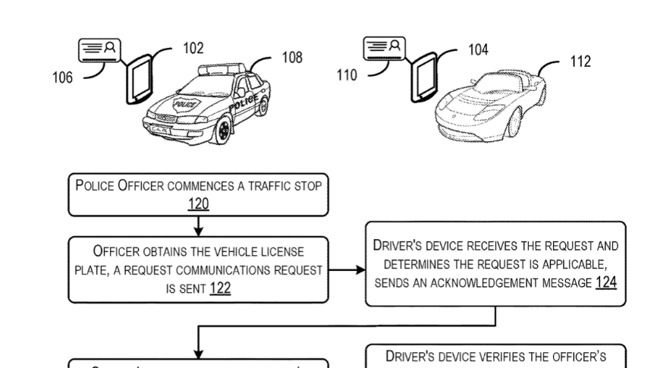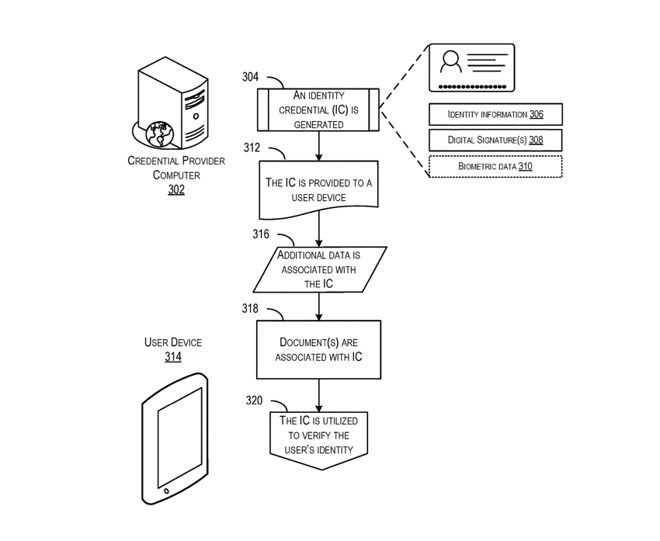Apple working on ways to securely present government ID from an iPhone or Apple Car
New research from Apple details methods that iPhone or Apple Car owners could securely store their identity credentials and securely share them with governmental agencies when required.

Detail from Apple's patent applications showing how a digital ID could be provided to law enforcement
Two new Apple patents together document methods for effectively replacing paper driving licenses or passports with a digital equivalent. The system would allow for many other situations where an identity must be confirmed, but the patents are concerned with the secure creation, storage and then -- significantly -- transmission to agencies such as law enforcement.
US Patent applications numbered 20190325125 and 20190327228, both titled "Identity Credential Verification Techniques," follow previous reports of Apple hoping to make iPhones central to ID security.
The two new patent applications separate out the functions of such systems into the creation or collection of a user's identity details, the later authentication of that ID, and then the user's ability to provide this detail on request.
"In today's electronically driven world, securely maintaining sensitive personal information about a user has become an important aspiration across various different industries," note both patent applications. "Having sound security procedures that collect only what information is necessary and securely communicating the information is paramount to maintaining a person's privacy rights as well as guarding against misuse of a person's personal information."
"[These patents regard], among other things, improving data security with respect to data collection, verification, and authentication techniques associated with obtaining and transmitting identity information," it continues.
The creation of an identity, it says, could be done by a government agency such as the US Department of Motor Vehicles.
"By way of example, the DMV may provision a credential that includes a person's driver's license information," it says. "In some embodiments, the credential may be digitally signed by using a private key of the DMV such that the identity credential may be verified using a public key associated with the DMV."
"Once provisioned," it continues, "a user may receive the identity credential electronically (e.g., via an application operating on the user's device). Subsequently, when the user desires to provide some portion of their identity information, the identity credential may be utilized to provide the information to another user device."
Apple's examples of providing that information include details of how law enforcement could request it at, for instance, traffic stops.

Detail from Apple's patent applications regarding the secure creation, storage and transmission of a digital ID
Using the driver's vehicle license plate, the officer's iPhone could request the driver's ID. Then the driver's iPhone could acknowledge the request but ask for, basically, the officer's own ID. If the driver accepts the officer's credentials, he or she could then respond via their iPhone.
"Driver's device [then] transmits at least a portion of the driver's identity credentials," notes Apple.
Already Germany and, separately, Japan have discussed plans to use iPhones to replace physical ID cards and passports. Similarly, the UK has been looking at the potential use of an iPhone app to identify EU citizens who have applied to continue living in the country after Brexit.
Recently, Apple Pay vice president Jennifer Bailey referred to how Apple sees mobile devices being used to verify identity.
"Identity, to be legal, it has to be government, it has to be authenticated by the government," she said. "We see, across the globe, many countries starting to use mobile to add a passport. You may use a mobile passport when you're going through airports today, and so it is moving and I think it will continue."

Detail from Apple's patent applications showing how a digital ID could be provided to law enforcement
Two new Apple patents together document methods for effectively replacing paper driving licenses or passports with a digital equivalent. The system would allow for many other situations where an identity must be confirmed, but the patents are concerned with the secure creation, storage and then -- significantly -- transmission to agencies such as law enforcement.
US Patent applications numbered 20190325125 and 20190327228, both titled "Identity Credential Verification Techniques," follow previous reports of Apple hoping to make iPhones central to ID security.
The two new patent applications separate out the functions of such systems into the creation or collection of a user's identity details, the later authentication of that ID, and then the user's ability to provide this detail on request.
"In today's electronically driven world, securely maintaining sensitive personal information about a user has become an important aspiration across various different industries," note both patent applications. "Having sound security procedures that collect only what information is necessary and securely communicating the information is paramount to maintaining a person's privacy rights as well as guarding against misuse of a person's personal information."
"[These patents regard], among other things, improving data security with respect to data collection, verification, and authentication techniques associated with obtaining and transmitting identity information," it continues.
The creation of an identity, it says, could be done by a government agency such as the US Department of Motor Vehicles.
"By way of example, the DMV may provision a credential that includes a person's driver's license information," it says. "In some embodiments, the credential may be digitally signed by using a private key of the DMV such that the identity credential may be verified using a public key associated with the DMV."
"Once provisioned," it continues, "a user may receive the identity credential electronically (e.g., via an application operating on the user's device). Subsequently, when the user desires to provide some portion of their identity information, the identity credential may be utilized to provide the information to another user device."
Apple's examples of providing that information include details of how law enforcement could request it at, for instance, traffic stops.

Detail from Apple's patent applications regarding the secure creation, storage and transmission of a digital ID
Using the driver's vehicle license plate, the officer's iPhone could request the driver's ID. Then the driver's iPhone could acknowledge the request but ask for, basically, the officer's own ID. If the driver accepts the officer's credentials, he or she could then respond via their iPhone.
"Driver's device [then] transmits at least a portion of the driver's identity credentials," notes Apple.
Already Germany and, separately, Japan have discussed plans to use iPhones to replace physical ID cards and passports. Similarly, the UK has been looking at the potential use of an iPhone app to identify EU citizens who have applied to continue living in the country after Brexit.
Recently, Apple Pay vice president Jennifer Bailey referred to how Apple sees mobile devices being used to verify identity.
"Identity, to be legal, it has to be government, it has to be authenticated by the government," she said. "We see, across the globe, many countries starting to use mobile to add a passport. You may use a mobile passport when you're going through airports today, and so it is moving and I think it will continue."

Comments
A good start would be expand on the Medical ID which is pretty basic in terms of information -- it doesn't even include your address or phone number. This could be greatly expanded to include general ID information that people use in daily living as well as in emergency situations.
Further, I am thinking that if ApplePay can securely communicate and pass critical financial data without exposing personal data then an ID system could as well.
This is all very doable -- I hope Apple stays on it and resolves the hodgepodge of obstacles blocking it from happening.
Police are not obligated to tell you the truth and will lie about your rights to get you to do something.
This is US-only advice:
https://m.youtube.com/watch?v=s4nQ_mFJV4I
At this point I'd be happy with a Driver's Wallet mode in the phone that does the above. No need for a federal ID system. The phone would have to be 'firewalled' so that should the officer take it back to the car, not only would any 'browsing' not be possible, but so would any other downloading or hacking.
I don't keep the registration in the vehicle, but in my actual wallet. That information is often a target of auto-burglaries. Even if it's not acted upon, it's a drag to have to go to the DMV to get it replaced.
But, there are certainly more private ways that that could be done -- the method used by ApplePay from either the phone or the watch would be most secure and effective.
I suspect the younger crowd will grow up expecting something like that. My grandson doesn't carry cash, keys or id with him -- but his phone is with him 24 hours a day.
https://lawallet.com/
Louisiana's Legal Digital Driver's License
100% Legal for driving purposes per Louisiana law of Act 625 of the 2016 season.
Louisiana State Police will accept the LA Wallet Digital Driver's License!
ATC legally approved all responsible vendors to accept LA Wallet for real-time age verification-required purchases and deliveries.
The LA Wallet App is made for Apple iOS and Android.
Activate it for the cost of 1 premium coffee for the life of your current physical license registration.
The iOS app went Live in the App Store Tuesday, June 26th, 2018! The Android version went live in the Google Play Store on July 2nd, 2018.
This application seems more suited to say, a watch or digital integration into driver’s license with a ’smart chip'. The watch does last multiple days on a single charge (my wife’s newer series 3 apple watch) or at least 14 hours (my 4 year old series 0 apple watch). And who needs a bar code? That’s 1980s technology. Just a near field interaction, like Apple Pay would be fine.